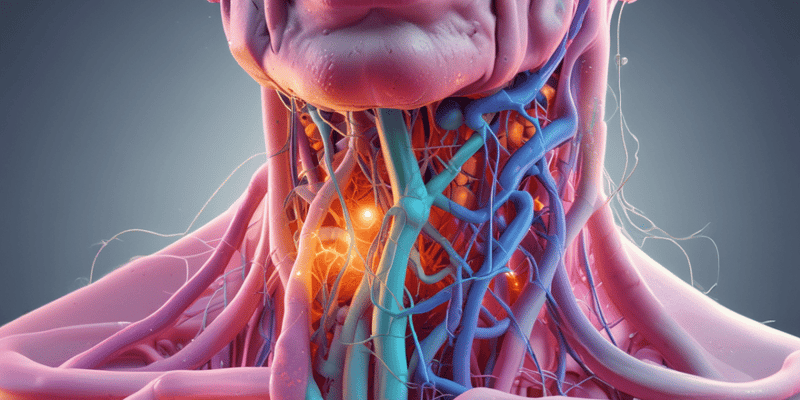Podcast
Questions and Answers
What should be monitored closely in patients receiving antiemetics?
What should be monitored closely in patients receiving antiemetics?
What is a nursing implication when treating nausea and vomiting?
What is a nursing implication when treating nausea and vomiting?
How should patients be advised regarding the use of ginger?
How should patients be advised regarding the use of ginger?
What is an important patient education topic regarding antiemetic medications?
What is an important patient education topic regarding antiemetic medications?
Signup and view all the answers
What is the recommended timing for administering antiemetics before chemotherapy?
What is the recommended timing for administering antiemetics before chemotherapy?
Signup and view all the answers
What is the role of antiemetic drugs?
What is the role of antiemetic drugs?
Signup and view all the answers
Where is the Vomiting Center (VC) located?
Where is the Vomiting Center (VC) located?
Signup and view all the answers
What triggers the Chemoreceptor Trigger Zone (CTZ)?
What triggers the Chemoreceptor Trigger Zone (CTZ)?
Signup and view all the answers
How do anticholinergic drugs work to prevent nausea?
How do anticholinergic drugs work to prevent nausea?
Signup and view all the answers
What is Scopolamine primarily used to treat?
What is Scopolamine primarily used to treat?
Signup and view all the answers
What effect do antiemetics have on vomiting symptoms?
What effect do antiemetics have on vomiting symptoms?
Signup and view all the answers
Which of the following is a common pathway triggering vomiting?
Which of the following is a common pathway triggering vomiting?
Signup and view all the answers
What is one of the main mechanisms of action for antiemetics?
What is one of the main mechanisms of action for antiemetics?
Signup and view all the answers
What is the primary mechanism of action of serotonin blockers in treating nausea?
What is the primary mechanism of action of serotonin blockers in treating nausea?
Signup and view all the answers
Which drug is an example of a tetrahydrocannabinoid used to manage chemotherapy-induced nausea?
Which drug is an example of a tetrahydrocannabinoid used to manage chemotherapy-induced nausea?
Signup and view all the answers
What effect do tetrahydrocannabinoids have on the body related to nausea and vomiting?
What effect do tetrahydrocannabinoids have on the body related to nausea and vomiting?
Signup and view all the answers
Which adverse effect is commonly associated with many antiemetics?
Which adverse effect is commonly associated with many antiemetics?
Signup and view all the answers
For which condition is phosphorated carbohydrate solution, like Emetrol, used off-label?
For which condition is phosphorated carbohydrate solution, like Emetrol, used off-label?
Signup and view all the answers
What is a significant consideration when using tetrahydrocannabinoids for nausea treatment?
What is a significant consideration when using tetrahydrocannabinoids for nausea treatment?
Signup and view all the answers
Which of the following represents a common side effect of antiemetic drugs?
Which of the following represents a common side effect of antiemetic drugs?
Signup and view all the answers
What property of ginger makes it a popular natural remedy for nausea?
What property of ginger makes it a popular natural remedy for nausea?
Signup and view all the answers
What is the primary mechanism of action of antihistamines?
What is the primary mechanism of action of antihistamines?
Signup and view all the answers
Which of the following is a common indication for the use of antihistamines?
Which of the following is a common indication for the use of antihistamines?
Signup and view all the answers
What potential complication is associated with long-term use of prokinetic drugs?
What potential complication is associated with long-term use of prokinetic drugs?
Signup and view all the answers
Which drug is classified as an antidopaminergic medication?
Which drug is classified as an antidopaminergic medication?
Signup and view all the answers
What is a key precaution when administering hydroxyzine?
What is a key precaution when administering hydroxyzine?
Signup and view all the answers
Which neurokinin receptor antagonist is a water-soluble prodrug?
Which neurokinin receptor antagonist is a water-soluble prodrug?
Signup and view all the answers
What is the main therapeutic use of prokinetic drugs?
What is the main therapeutic use of prokinetic drugs?
Signup and view all the answers
Which of the following is a potential use for antidopaminergic drugs?
Which of the following is a potential use for antidopaminergic drugs?
Signup and view all the answers
Study Notes
Serotonin Blockers
- Block serotonin receptors in the gastrointestinal (GI) tract, chemoreceptor trigger zone (CTZ), and vomiting center (VC)
- Used for nausea and vomiting in chemotherapy and post-operative patients
- Examples: Dolasetron (Anzemet), Granisetron (Kytril), Ondansetron (Zofran), Palonosetron (Aloxi)
Tetrahydrocannabinoids
- Primary psychoactive component in marijuana
- Exert inhibitory effects on the brain's reticular formation, thalamus, and cerebral cortex
- Clinically used to manage chemotherapy-induced nausea and vomiting, and anorexia in HIV/AIDS patients
- Example: Dronabinol (Marinol)
Phosphorated Carbohydrate Solution
- Emetrol is a mint-flavored oral solution, used off-label for morning sickness
- Mint flavor may improve palatability and patient compliance
- Effective for nausea and vomiting and considered relatively safe
Adverse Effects of Antiemetics
- Drowsiness
- Dry mouth
- Blurred vision (antihistamines)
- Constipation
Ginger for Nausea
- Natural remedy used to treat nausea and vomiting
- Conditions treated include chemotherapy-induced nausea, morning sickness, and motion sickness
- Possible side effects: mild gastrointestinal upset, skin reactions
- May increase the absorption of oral medications and bleeding risk with anticoagulants
Nursing Implications
- Thoroughly assess the patient's history of nausea and vomiting and note precipitating factors
- Carefully review the patient's current medications and identify potential drug interactions
- Check for contraindications and assess for allergies
- Warn patients about drowsiness and advise against operating machinery
- Educate patients on potential drug interactions, such as with alcohol
- Emphasize slow position changes to prevent hypotension
- Closely monitor patients for both therapeutic and adverse effects, including nausea, vomiting, and other symptoms
- Administer antiemetics 30-60 minutes before chemotherapy
Definitions: Nausea and Vomiting
- Nausea: Unpleasant sensation that often precedes vomiting
- Emesis (Vomiting): Forcible emptying of gastric contents, occasionally intestinal contents as well
- Antiemetic drugs: Used to treat nausea and vomiting, effectively relieving symptoms
Vomiting Center and Chemoreceptor Trigger Zone
- Vomiting Center (VC): Located in the medulla oblongata, receives signals from various sources and initiates the vomiting reflex when stimulated
- Chemoreceptor Trigger Zone (CTZ): Near the VC, but outside the blood-brain barrier, detects toxins in the blood and coordinates with the VC to initiate emetic responses
Antiemetics and Antinausea Drugs: Mechanism of Action
- Vomiting Pathways: Multiple pathways trigger vomiting, antiemetics block these
- Neurotransmitter Blockade: Many drugs block neurotransmitters to prevent the vomiting signals
- Receptor Interactions: Drugs bind to receptors to inhibit vomiting signals
Anticholinergic Drugs
- Block acetylcholine (ACh) receptors, preventing transmission of nausea-inducing stimuli to the CTZ
- Interrupt signals from the reticular formation to the vomiting center
- Example: Scopolamine (Transderm-Scōp, Scopace) - available as a 72-hour transdermal patch, effective in preventing motion sickness and postoperative nausea
Antihistamine Drugs
- Inhibit ACh by binding to H1 receptors, preventing cholinergic stimulation
- Effective in treating motion sickness, nonproductive coughs, and allergy symptoms
- Some provide sedation
- Examples: dimenhydrinate (Dramamine), diphenhydramine (Benadryl), meclizine (Antivert), hydroxyzine (Vistaril)
Antidopaminergic Drugs
- Block dopamine receptors in the CTZ to reduce nausea and vomiting
- Other indications: psychotic disorders, intractable hiccups
- Examples: Prochlorperazine (Compazine), promethazine (Phenergan), amisulpride (Barhemsys), droperidol
- Preferred administration routes: oral and intramuscular, IV route is common but not preferred
- Droperidol use is controversial due to cardiac risks
Neurokinin Receptor Antagonists
- Inhibit substance P/neurokinin 1 receptors, reducing chemotherapy-induced nausea
- Examples: Aprepitant, Fosaprepitant (water-soluble prodrug of aprepitant), Rolapitant
Prokinetic Drugs
- Block dopamine receptors in the CTZ, desensitizing the CTZ to GI tract impulses
- Stimulate GI tract peristalsis, enhancing stomach emptying
- Other indications: gastroesophageal reflux disease, delayed gastric emptying
- Example: Metoclopramide (Reglan) - long-term use may cause tardive dyskinesia
Studying That Suits You
Use AI to generate personalized quizzes and flashcards to suit your learning preferences.
Related Documents
Description
This quiz covers various antiemetics, including serotonin blockers, tetrahydrocannabinoids, and phosphorated carbohydrate solutions. You will also explore the adverse effects associated with these medications and the use of ginger for nausea management. Test your knowledge of these important pharmacological agents in treating nausea and vomiting.




